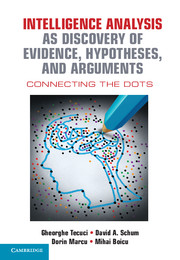Book contents
- Frontmatter
- Contents
- Preface
- Acknowledgments
- About the Authors
- 1 Intelligence Analysis: “Connecting the Dots”
- 2 Marshaling Thoughts and Evidence for Imaginative Analysis
- 3 Disciple-CD: A Cognitive Assistant for Connecting the Dots
- 4 Evidence
- 5 Divide and Conquer: A Necessary Approach to Complex Analysis
- 6 Assessing the Believability of Evidence
- 7 Chains of Custody
- 8 Recurrent Substance-Blind Combinations of Evidence
- 9 Major Sources of Uncertainty in Masses of Evidence
- 10 Assessing and Reporting Uncertainty: Some Alternative Methods
- 11 Analytic Bias
- 12 Learning and Reusing Analytic Expertise: Beyond Disciple-CD
- Glossary of Terms
- References
- Appendixes
- Index
8 - Recurrent Substance-Blind Combinations of Evidence
Published online by Cambridge University Press: 05 August 2016
- Frontmatter
- Contents
- Preface
- Acknowledgments
- About the Authors
- 1 Intelligence Analysis: “Connecting the Dots”
- 2 Marshaling Thoughts and Evidence for Imaginative Analysis
- 3 Disciple-CD: A Cognitive Assistant for Connecting the Dots
- 4 Evidence
- 5 Divide and Conquer: A Necessary Approach to Complex Analysis
- 6 Assessing the Believability of Evidence
- 7 Chains of Custody
- 8 Recurrent Substance-Blind Combinations of Evidence
- 9 Major Sources of Uncertainty in Masses of Evidence
- 10 Assessing and Reporting Uncertainty: Some Alternative Methods
- 11 Analytic Bias
- 12 Learning and Reusing Analytic Expertise: Beyond Disciple-CD
- Glossary of Terms
- References
- Appendixes
- Index
Summary
We have considered a categorization of individual items of evidence but have also mentioned situations in which individual items can reveal various mixtures of the types of evidence shown in Figure 6.1 (p. 119). We now consider combinations of two or more individual items of evidence. These combinations are also recurrent and do not involve the substance or content of the evidence.
There are three main classes of evidence combinations – harmonious, dissonant, and redundant – all of which we may encounter in a mass of evidence being considered in an intelligence analysis or an analysis in any other context.
HARMONIOUS EVIDENCE
Basic Forms Of Harmonious Evidence
Two or more items of evidence are harmonious if they are directionally consistent in the sense that they all point toward, or favor, the same hypothesis or possible conclusion.
There are two basic forms of harmonious evidence. The first is called corroborative evidence. In this combination of evidence, we first have two or more sources telling us that the same event has occurred. Suppose both of these sources report that event E has occurred. Directional consistency is apparent here since E is consistent with itself. The sources of corroborative evidence may be any combination of the “INTs” we have mentioned. For example, we may have both IMINT and HUMINT telling us that a certain event has occurred at a location at a certain time. Or, we may have IMINT and COMINT both saying that a certain event occurred. This form of corroboration often, but not always, allows us to have greater confidence that the event in question did occur. In such cases, we would say that one source has verified what the other source has told us. The exception involves instances in which we have other evidence suggesting that two or more HUMINT sources collaborated in deciding what to tell us, or that one source influenced or coerced another source to report the same event. As we know, HUMINT sources are frequently not independent; they can interact in ways designed to deceive us.
- Type
- Chapter
- Information
- Intelligence Analysis as Discovery of Evidence, Hypotheses, and ArgumentsConnecting the Dots, pp. 148 - 158Publisher: Cambridge University PressPrint publication year: 2016

